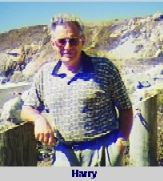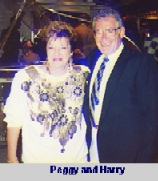MM Looks Forward To 50th Wedding Anniversary
Harry and his wife Peggy moved from New York City to Las Vegas in 1987 to enjoy their retirement in a warm climate. Harry was an avid walker who was happy to hoof about 3 miles every day. In June of 1997, Harry began having breathing problems and coughing fits. Eventually, even tying his shoes became a burden. He sought medical attention from his local doctors in Las Vegas.
A chest film showed a large left-sided pleural effusion. His doctors asked him about his occupation and Harry advised that he had worked at the Brooklyn Navy Yards from 1943 to 1959, before he began his professional career as an electrical engineer. Harry's doctors suspected mesothelioma.
In order to relieve the pressure against his lung, a ultrasound-guided thoracentesis was performed, from which bloody fluid was removed. The cytology was negative for tumor. Harry felt some relief but the fluid quickly reaccumulated. Less than one month later, Harry had to have a second drainage. In December, Harry underwent bronchoscopy and a thorascopy, during which talc was inserted into his pleural space. His surgeons found multiple areas of pleural studding with hard plaquish material. A biopsy was taken and found to be consistent with mesothelioma. The pathologists in Las Vegas sought a second opinion from the Mayo Clinic in Scottsdale, Arizona. Dr. Thomas Colby (who is a member of the US-Canadian Mesothelioma Panel) confirmed the diagnosis.
Harry, who was noted by his doctors in their records to be "extremely intelligent", set about to research his treatment options. He visited with various doctors at the Mayo Clinic in Scottsdale, including a thoracic surgeon and an oncologist. Dr. Arcidi, the thoracic surgeon at the Mayo Clinic, advised Harry that surgery was not recommended. At that time, he was stage II (by CT scan), with a history of coronary bypass surgery in 1980 and factor XI deficiency. Dr. Arcidi advised that the only treatments available were palliative in nature and, further, that it was difficult to predict the future. On an optimistic note, his doctors noted that Harry's symptoms were under control and that his diffuse tumor, which was epithelial, appeared to be "indolent." In the event the tumor progressed, the doctors recommended a systemic chemotherapy regimen using Adriamycin.
Harry then set up appointments with his pulmonary doctor in Las Vegas. They have been monitoring the tumor closely via CT scan and chest film. Harry visited our website and asked for information about the thoracic surgeon at UCLA Medical School in Los Angeles, Dr. Robert Cameron.
On February 12, 1998, Harry, who is 70 years old, met with Dr. Cameron. Since the talc pleuradesis, he had not had any serious chest discomfort. Dr. Cameron reviewed the CT films and medical records and outlined the following options: (1) no further treatment, (2) a radical extrapleural pneumonectomy (EPP), (3) pleurectomy / decortication with intrapleural chemotherapy and postoperative radiation, and (4) numerous experimental therapies, including gene therapy (for which he was not eligible because of his talc pleurodesis), IL-R immuntoxin (not currently available at UCLA), photodynamic therapy, possible anti-angiogenesis therapy (not currently available at UCLA).

Dr. Cameron believed that Harry was an excellent candidate for the third option -- pleurectomy / decortication, along with intrapleural chemotherapy and postoperative radiation. The upsides were this procedure might prolong his survival "slightly" without exposing him to the serious risk of complications that can be associated with the EPP procedure. According to Harry, the doctor gave him two weeks to decide. Dr. Cameron was clear that there was not a one size fits all, silver bullet cure for this disease.
Harry and Peggy returned to Las Vegas to ponder their options. Meanwhile, Harry called Dr. Hahn at the University of Pennsylvania, who was reported to be an expert with photodynamic therapy. Dr. Hahn returned his call and asked for the medical records, which Harry mailed to him. Within a matter of hours, Dr. Hahn called back and explained that his procedure was not unlike the procedure outlined by Dr. Cameron in terms of "aggressiveness" and would involve risks.
As you can imagine, Harry and Peggy were somewhat overwhelmed by all the doctors, the treatment options, the radical nature of the surgeries, and the risks. Compounding the problem was the fact that Harry was not experiencing acute symptoms. Harry testified in his deposition, taken in Las Vegas on March 23, 1998, that at that time, back in early February, he was "in a state of shock. We decided to stay with our local doctors, monitor my lungs and take a wait and see approach."
Currently, Harry has begun to feel progressively short of breath and has developed sharp spasms in his left side. He coughs, but not as frequently as he did before the talc pleurodesis. Before his symptoms, he used to swim ½ to 1 hour a day. Now he does not swim at all. He used to enjoy bowling 3-4 times per week; now he's lucky to bowl once a week. And where he was accustomed to walking 3 miles every day, now he has to dig deep to walk a mile on a very good day.
What Harry has that doctors can't prescribe is spirit. Call it faith, call it hope, call it a "sunny disposition," call it whatever you want, but Harry has a buoyant, optimistic approach to life that is priceless. He and Peggy have faced crises before. Harry knows the importance of keeping your head up and sticking to your plan. In the 1950s, while working full time in the Brooklyn Navy Yards as an electrician, he was also attending night school at Columbia University and Brooklyn Polytech, while at the same time raising two children, both of whom today are very successful professionals. Harry doesn't recognize the words "failure" or "quit." He will persevere, but he is human, and he and his wife can't help worrying with every new cough, or muscle spasm, or painful inspiration.
As he says with a smile, "Peggy and I have been happily married for 48 years. I'm looking forward to celebrating our 50th wedding anniversary."
** POSTED MARCH 27, 1998 **
Harry passed away on July 30, 1998


